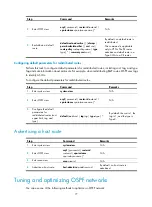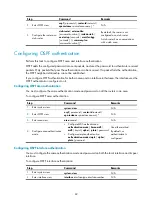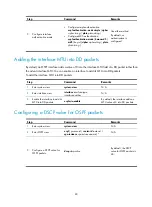
85
To enable compatibility with RFC 1583:
Step Command
Remarks
1.
Enter system view.
system-view
N/A
2.
Enter OSPF view.
ospf
[
process-id
|
router-id
router-id
|
vpn-instance
vpn-instance-name
] *
N/A
3.
Enable compatibility
with RFC 1583.
rfc1583 compatible
By default, this feature is enabled.
Logging neighbor state changes
Perform this task to enable output of neighbor state change logs to the information center. The
information center processes the logs according to user-defined output rules (whether to output logs and
where to output). For more information about the information center, see
Network Management and
Monitoring Configuration Guide
.
To enable the logging of neighbor state changes:
Step Command
Remarks
1.
Enter system view.
system-view
N/A
2.
Enter OSPF view.
ospf
[
process-id
|
router-id
router-id
|
vpn-instance
vpn-instance-name
] *
N/A
3.
Enable the logging of
neighbor state changes.
log-peer-change
By default, this feature is
enabled.
Configuring OSPF network management
This task involves the following configurations:
•
Bind an OSPF process to MIB so that you can use network management software to manage the
specified OSPF process.
•
Enable SNMP notifications for OSPF to report important events.
•
Configure the maximum number of output SNMP notifications within a specified time interval.
SNMP notifications are sent to the SNMP module, which outputs the notifications according to the
configured output rules. For more information about SNMP notifications, see
Network Management and
Monitoring Configuration Guide
.
To configure OSPF network management:
Step Command
Remarks
1.
Enter system view.
system-view
N/A
2.
Bind OSPF MIB to an
OSPF process.
ospf mib-binding
process-id
By default, OSPF MIB is bound to
the process with the smallest
process ID.















































